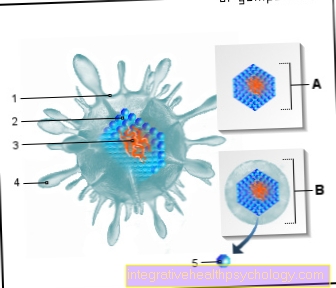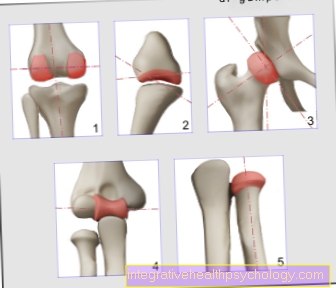The build up of viruses
introduction
Viruses are tiny parasites that are potential pathogens. They are common everywhere and can be found in every cell. Like other parasitic organisms, they need a foreign organism to reproduce. For example, plants, animals or humans can be considered. Viruses infecting a weak immune system or weak people, such as children, can lead to infection. The viruses enter the body through body openings such as the mouth, nose, eyes or through sexual intercourse. Nowadays one can protect oneself against some infectious diseases with vaccinations and suitable contraception.
Well-known infectious diseases that are transmitted via viruses are AIDS (HI virus) or measles in children.

How is a virus structured?
A virus is a tiny organism that can only be viewed with an electron microscope. In terms of their size, the viruses are in the nanometer range, although there are certainly larger (Marburg virus with around 1,000 nm) and smaller viruses (poliovirus with a diameter of around 30 nm). Since viruses belong to the obligatory parasites, they are not able to operate a metabolism and therefore depend on a host cell.
Viruses are made up of a few components. Like other organisms, their genetic makeup consists of nucleic acid. Depending on the virus, these can be assigned to either DNA or RNA. Furthermore, this genetic material can be present in the virus in many different forms.For example, the genetic material can consist of either a single strand or a double strand and be straight or circular in shape. Overall, the nucleic acid can take up to 30% of the total weight of the virus.
Read more to DNA.
The genome of the virus is enveloped by structural proteins (capsomeres) that protect the genetic material from environmental influences. In their entirety, these structural proteins are called capsids because they form a kind of capsule around the DNA / RNA. The complex of capsid and nucleic acid is called a nucleocapsid.
Depending on the type of virus, there is also a virus envelope. This includes a double shell made of fat (lipid shell), which comes from the shell of the host cell. If viruses have such a fatty envelope, they are called enveloped viruses, the rest are naked viruses. Enveloped viruses are sensitive to fat-soluble substances. Such viruses lose their infectivity when they are treated with fat-soluble chemicals. For this reason, naked viruses are often more resistant than enveloped viruses. Glycoproteins can also be stored in this fatty envelope, which are thus located on the surface of the virus. These are visible in the electron microscope as small extensions and are known as spikes. Their function is to attach themselves to the desired host cell and thus help the virus to penetrate.
Some viruses also contain special enzymes. An example of this is the human immunodeficiency virus (HI virus), which is a retrovirus and has a reverse transcriptase. This enzyme is able to transcribe an RNA into a DNA. Reverse transcriptase is also the target of various substances that are administered as drugs against the infectious disease.
Find out more here Enzymes.
Illustration of a virus

Viruses (singular virus)
- Virus envelope
Lipid bilayer - Capsule (capsid)
Protein shell
Capsomeres - nucleic acid
(RNA or DNA viruses)
Ribonucleic acid
Deoxyribonucleic acid - Membrane proteins
Lipid proteins (spikes) - Capsomer (subunit)
A - non-enveloped virus
(Nucleic capsid)
B - enveloped virus
(Virion)
Construction from:
Genetic material - Nucleic acids
Proteins - Proteins
Lipids (sometimes)
You can find an overview of all Dr-Gumpert images at: medical illustrations
How do viruses differ in their structure?
The many viruses can be divided into different groups according to their structure.
An important criterion for the classification is the type of nucleic acid. Some viruses encode their genetic material with DNA, others use RNA for this.
With regard to the genome, further classification criteria can be determined. A distinction is made between single-stranded and double-stranded nucleic acids. In addition, this can be straight (linear) or circular (circular) in the virus.
The genetic material of a virus does not necessarily have to be available as a whole, but can also be divided into fragments. In this case one speaks of a virus with a segmented nucleic acid.
In addition to DNA and RNA viruses, there are viruses that use a reverse transcriptase. This enzyme is so special that such viruses are once again understood as a separate group. These viruses are able to transcribe their RNA into DNA and integrate it into the DNA of the host cell.
The capsid, i.e. the envelope of the genome made of structural proteins, can also be in various forms. These range from a helical shape and a cubic structure to an icosahedral envelope of the nucleic acid.
Another striking distinguishing feature of viruses is the presence or absence of a fatty envelope (lipid envelope). This surrounds the nucleocapsid, so that one speaks of enveloped or naked viruses. Well-known viruses that have a shell made of fats are, for example, the herpes viruses and the HI virus.
The structure of known viruses
HI virus ("HIV")
The HI virus ("HIV", human immunodeficiency virus) belongs to the retroviruses and belongs to the lentivirus genus. The HI virus is around 100nm in size and is therefore one of the larger viruses.
The HIV virus genome consists of two single-stranded RNAs that can be transcribed into DNA by reverse transcriptase. Inside the capsid there is not only the RNA, but also the reverse transcriptases and intergrases. With the help of these enzymes, the genetic information transcribed in DNA can be incorporated into the DNA of the host cell and thus spread throughout the organism. In addition, there are proteases throughout the virus, which are involved in the formation of new infectious viruses.
The presence of a double lipid layer makes it an enveloped virus. Various surface proteins are stored in this fatty shell. In addition, under the electron microscope you can see about 10 to 15 processes per HIV virus that protrude from the fatty envelope. These so-called spikes are protein complexes that play an important role in the path of infection. With the help of the spikes, the HI virus recognizes the target cells that develop all CD4 receptors. The target cells of the HIV virus include in particular T helper cells (part of the adaptive immune system), which weaken the immune system of the infected patient.
Learn more about this topic: HI virus and HIV
Flu virus
The flu or influenza virus can trigger the "real" flu (influenza), which has enormously stronger symptoms than a common cold. There are several types of the flu virus, which differ in their structure in small details. However, all flu viruses have the same basic structure. The flu virus
- is about 100nm in size,
- belongs to the RNA viruses,
- has eight single-stranded RNA strands as genetic material, which are often present as fragments,
- is surrounded by a layer of fat, so that one speaks of an enveloped RNA virus and
- contains several enzymes, such as the RNA polymerase complex (responsible for the replication of the genetic material)
For more information on the disease causing the virus, see Flu.
Measles virus
The measles virus triggers the childhood disease measles. This pathogen only affects humans, so that the only source of infection is a sick person.
The measles virus is a large virus with 100 to 250nm. It belongs to the RNA viruses and is wrapped in fat (lipid shell). This enveloped RNA virus can be assigned to the group of paramyxoviruses, all of which are transmitted via droplet infection. This means that the pathogen is distributed through the air, triggered by, for example, sneezing, coughing or simply speaking. An infection with the virus almost always leads to an outbreak of measles.
The simplest protection against this disease is a vaccination in childhood. Often this is offered as a combination vaccination, so that one is protected against measles, rubella and mumps at the same time.
Read about that Measles vaccination
Hepatitis B virus
The hepatitis B virus causes hepatitis B, an inflammation of the liver. This infectious disease is the most common worldwide and can lead to liver cirrhosis or liver cell carcinoma.
The virus is an enveloped DNA virus, whereby the genetic material is partly double-stranded. In addition, the hepatitis B virus, like the HI virus, has a reverse transcriptase. This enzyme transcribes RNA copies of the genome into DNA. This viral genetic information is then incorporated into the host cell's DNA. The virus is now in the infected liver cells, which makes therapy more difficult.
Today vaccination against hepatitis B is possible and is recommended for children. If you already have a disease, you can use various substances that are directed against the viruses (antivirals). However, this treatment has a wide variety of side effects.
Learn more about transmission routes, symptoms and treatment options for Hepatitis B.
Further information
You may also be interested in the following topics:
- DNA
- Enzymes
- HI virus
- Measles vaccination
- Hepatitis B.





























